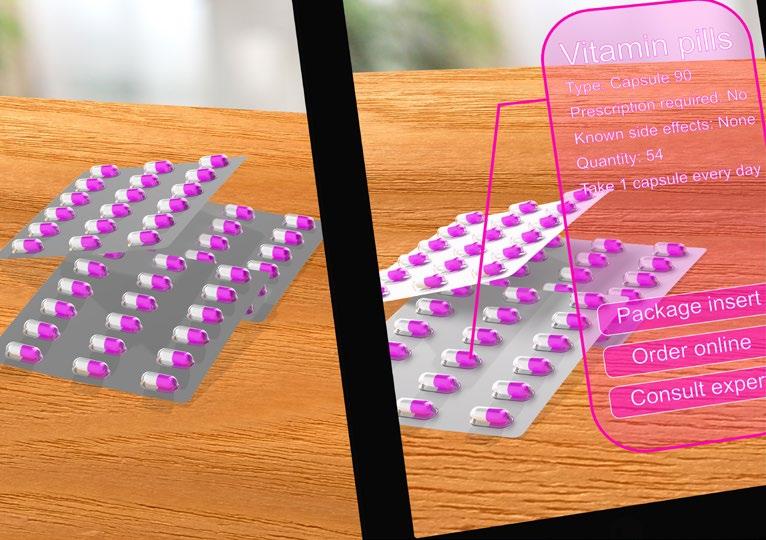
4 minute read
Communicating with smart packaging
Communication through smart packaging
By Christopher Waterhouse, Managing Director, iDi Pac Ltd
Advertisement
New technologies can be used to influence patient behaviour, improve communications and adherence to medication regimes resulting in improved outcomes.
he largest single therapeutic area and issue facing the pharmaceutical industry is regimen treatment adherence and product communications. It is a widely held belief that much of this issue can be addressed through use of innovative and cost-effective packaging solutions.
The pharmaceutical industry knows that on average only 50% of prescribed prescription drugs are consumed as required. It follows therefore that there may be a potential doubling of industry sales annually, currently estimated at around US$ 1 trillion. This suggests a major opportunity and something that the world of packaging can do so much to support with a much smaller budget than typical allocated to R&D activity in more resource intensive areas – oncology, pain relief, diabetes and so forth. And for the patient community, in the US failure to adhere to regimen is estimated to cause around 125,000 US deaths annually, with non-adherence largely grouped under the categories of communication and complexity. It is suggested therefore that both Rx and OTC pharmaceuticals would benefit from enhancements in the communication and other smart technologies delivered through the packaging systems; communication and an improved patient experience via integration with the Internet of Things (IoT) and other digital technologies.
Smart technologies The smart phone has the power and capability to drive adoption of on-pack solutions, be they RFID, NFC or more cost effectively, Smart Code systems. The provision of communication can be leveraged – as stated earlier the correlation between communication and adherence is well known. Smart phones now have the capability to read the variety of bar codes that can provide both fixed and dynamic links to allow access to e-PILs (electronic patient information leaflet), which can be presented with enhanced colours, be customisable with respect to the order of presentation, accessible in regards the data delivery and language, eg audio and so forth.
A further benefit of this approach is the removal of the printed PIL. Manufacturing plants frequently cite that insertion of some of the
estimated 25 billion PILs annually lowers line speeds and efficiency. Given the annual cost of PILs is estimated at around £250 million with a huge tonnage of paper consumed, removal is therefore of benefit assuming access is maintained to all in some form.
The next obvious development is to generate calendar reminders to take the drugs through the smart phone’s inherent capability. This is hugely powerful, connecting the patient, communications and adherence easily and cost effectively. The smart barcodes/ phones will also link and deliver other rich data, such as audible and video relating to patient information, ingredients, adherence and more, making access easy for those with visual impairment or in regions where literacy is an issue. To date, unit on-cost of chip technologies has been prohibitive. Smart barcode technologies with reduced costs; a secure two-way connection to an information platform with enhanced and associated content merely from scanning a standard printed product barcode using an app on a smart device – this must be good! A major advantage to brands implementing this technology is that there are no artwork changes nor physical packaging modifications required, which are often a barrier to entry for some tech solutions.
Gaming experience Upping the ante now, smart technologies utilising augmented reality (AR) capabilities are also proving valuable within the wider medical field. They can provide remote video support, training aids and real-time overlays during surgical procedures.
Over recent years, a significant number of global companies have been experimenting with virtual or AR content as part of their media and communication strategies. Familiarity is building, as the growing middle classes in emerging markets are increasingly seeing AR in the home (often in the West for immersive gaming experiences). It is now but a matter of time before AR is more widely utilised for at-home medication uses – maybe visual overlay guides for newly diagnosed diabetics to assist with rotation of insulin injection sites as an example – again enhancing communications.
Some animation companies now specialise in the pharma arena as the demand from the market for training and promotional content grows. Thus, the creative foundations for adoption of AR as patient guidance are already in place. With the potential of hosted brand channels securely accessible from smart devices, via scannable packaging, delivery of educative AR content tailored to the patients’ needs is already available.
Future opportunities We have started with global serialisation, which is clearly a scannable technology. The next steps seem logical in that Big Pharma might have to consider the coding of the individual pill or dispenser to facilitate the delivery of the specific data sets on the smart device. Specialist and complex medicinal needs could be managed and customised, and regimes easily scheduled and dispensed, thus taking any guesswork out of the mix for the patient.
The benefits for early adopters of the technology within pharma are far reaching. Increased medicinal compliance improves quality of life and patient outcomes, decreasing pressure on health services. Conservatively the pharma industry can significantly improve its sales channel and the quantifiable results include better patient outcomes, increased sales numbers, and lower drug costs. On top of that brand value and product effectiveness elevate early adopters to be the prescribed ‘brand of choice’ for medical practitioners and ultimately for the brand to achieve the nirvana of peer group endorsement.
So, growth of sales, improvements in patient outcomes, endorsement by the medical profession … what is not to like???











